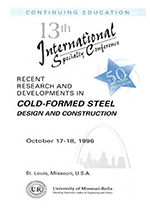Session Dates
17 Oct 1996
Abstract
For thin-walled flexural members composed of certain geometric proportions and/or made of high-strength steel, a mode of buckling at half-wavelengths intermediate between local buckling and flexural-torsional or flexural buckling can occur. The mode is most common for edge (lip) stiffened members such as C and Z-sections, and involves rotation of the lip-flange component about the flange-web junction. This mode is commonly called distortional buckling. Presented in this paper is a design method for distortional buckling of flexural members recently submitted for ballot with the AISI Specification Committee for Cold-Formed Steel Structures. Currently, the North American Cold-Formed Steel Design Standards do not contain such a distortional buckling provision. The distortional buckling procedure is compared with the current North American Design Standards using the results of beam tests carried out at the University of Waterloo and data available in the literature. Statistical results of the investigation indicate that the distortional buckling method is slightly conservative yet provides a better fit to the test data in comparison with current Design Standards. More importantly, the distortional buckling procedure accounts for recently observed significantly unconservative test results. It is recommended that the design method for the distortional buckling of flexural members, using Strength Curve 1 as presented herein, be adopted by the North American Design Standards.
Department(s)
Civil, Architectural and Environmental Engineering
Research Center/Lab(s)
Wei-Wen Yu Center for Cold-Formed Steel Structures
Meeting Name
13th International Specialty Conference on Cold-Formed Steel Structures
Publisher
University of Missouri--Rolla
Document Version
Final Version
Rights
© 1996 University of Missouri--Rolla, All rights reserved.
Document Type
Article - Conference proceedings
File Type
text
Language
English
Recommended Citation
Rogers, Colin A. and Schuster, R. M., "Comparison of the Distortional Buckling Method for Flexural Members with Tests" (1996). CCFSS Proceedings of International Specialty Conference on Cold-Formed Steel Structures (1971 - 2018). 2.
https://scholarsmine.mst.edu/isccss/13iccfss/13iccfss-session2/2
Comparison of the Distortional Buckling Method for Flexural Members with Tests
For thin-walled flexural members composed of certain geometric proportions and/or made of high-strength steel, a mode of buckling at half-wavelengths intermediate between local buckling and flexural-torsional or flexural buckling can occur. The mode is most common for edge (lip) stiffened members such as C and Z-sections, and involves rotation of the lip-flange component about the flange-web junction. This mode is commonly called distortional buckling. Presented in this paper is a design method for distortional buckling of flexural members recently submitted for ballot with the AISI Specification Committee for Cold-Formed Steel Structures. Currently, the North American Cold-Formed Steel Design Standards do not contain such a distortional buckling provision. The distortional buckling procedure is compared with the current North American Design Standards using the results of beam tests carried out at the University of Waterloo and data available in the literature. Statistical results of the investigation indicate that the distortional buckling method is slightly conservative yet provides a better fit to the test data in comparison with current Design Standards. More importantly, the distortional buckling procedure accounts for recently observed significantly unconservative test results. It is recommended that the design method for the distortional buckling of flexural members, using Strength Curve 1 as presented herein, be adopted by the North American Design Standards.



